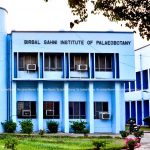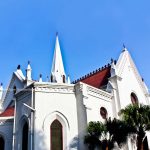Bhatkhande
Restoration of the Glory of Performing Arts
Art is the identity of a culture. The music, dance, literature etc. of a place go on to narrate the growth, development and current state of its people. Music especially, was not only a medium of entertainment but has also been instrumental in shaping the minds of the masses. While folk music was a really strong way of storytelling, many faiths have also associated music with their rituals and even acknowledged it as a path to unite with the almighty, for instance, Church Choirs and Sufis.
In India, too, music has been an integral part of the culture. From folk songs in the local spheres to Bhajans, Aarti or Nohas, music was the source of recognition to any and every occurrence throughout the society. Even in the present times, Indian music represents the artistic side of the spiritual ideology of our country, which is a means of realization of delight and salvation. But in the luxuriant middle age, it was sent to brothels as a means of enjoyment and luxury and was connected to prostitution. The world dodged the use of music and dance, after it had become so undignified. Only folk music and dance were prevalent which had relentless reputation.
In the modern era, when there was a wave of awareness everywhere and talk of upliftment of music was on peak, movement of reconstruction of music started. Bhatkhande Music Institute (old name- Marris Music College) was a consequence of this movement. Today, Bhatkhande Music Institute has emerged as one of the most prominent institutes to provide excellent artistic education and values to the youth across the nation.
On August 10, 1860, Pandit Vishnu Narayan Bhatkhande, who was born in Maharashtra, decided to open a music institute in the town to provide the scientific educational knowledge in music. For this, first he took the consent of all music lovers in the country. His sole aim was to bring music from the gatherings of palaces, prostitutes etc. to a healthy environment. In 1916, he discussed this idea in the Vishal Sangeet Sammelan in Baroda and with the same intention, on July 8, 1926, he founded Akhil Bhartiya Sangeet Mahavidyalay in Tope-wali kothi, near china market, Qaisarbagh. Pandit Vishnu Narayan Bhatkhande traveled in India to find threads of music and then he published a book on Indian Music Methods with music scores. He also published two books in Sanskrit, by the name of Lakshya Sangeet and Abhinav Raag Manjari.
Inspired by Pandit Bhatkhande, outline of this institute was prepared in 1924-25 at the annual session of Akhil Bhartiya Sangeet Parishad, held in Lucknow. Baron Dariyabad Awadh and then educational minister Rai Rajeshwar Bali indulged actively in the making of this University. Raja Barkhandi, Raja Nawab Ali (from Akbar District), Nawab Sahab Rampur, Rai Bahadur Chandrabali and Atul Prasad Sen also participated in this initiative. Raja Nawab Ali was an accomplished harmonium player and he is still remembered for his talent. This University was duly inaugurated on March 16, 1926 by the governor of united provisions of Agra and Awadh, Sir William Marris, in the same Tope-wali Kothi and hence named after him, Marris College of Indian Music. Initially all these music lovers used to sit on the floor and play music themselves on harmonium, sitar etc. because the boys and girls were reluctant to join the institute. In the same time on the other side of Qaisarbagh Chauraha, a fruit and vegetable market, named as Marris Market was established and was recognized by the State Government on March 20, 1926.

With the continuous efforts of arduous music lovers some people took admission in this institute and when the number of student increased in August 1928, institute was shifted to the building of old chambers and Canning College, whose architecture was built traditionally in 1878. Madhav Music Academy of Gwalior and Baroda Music College were also founded with the inspiration from Pandit Bhatkhande. The first principal of Marris Music College was Raghav Rao Keshav Joshi. When he retired in September 1928 one of the favorite students of Pandit Bhatkhande, Krishna Narayan Ratanjakar became the principal, whose dedicated lifelong services will always be remembered. Many popular artists studied and graduated from this college. Shri Govind Narayan Naatu, Chotte Munna Kha Khayaliye and Ustaad Ahmad Kha Dhrupdiye used to teach vocal music in the institute. Ustaad Aabid Ali Hussain Kha Khalifa taught tabla and Dr. Sakhavat Hussain Kha taught Sarod. Apart from them many prominent professors like Rahim-ud-din Kha Daagar, Ahmand Jaan Thirakva, Begam Akhtar, V.G. Jog, and Ustaad Yusuf Ali Kha taught different musical instruments in this college. In 1936, the institute started providing training in Kathak. Ramlal Kathik took responsibility of this training course. Marris Music University was founded in 1939.
Marris Music University was named Bhatkhande Music University in 1960 in a tribute to Pandit Bhatkhande on his 100th birthday. U.P government in 1966 recognized this. In November 1952, the then President, Dr. Rajendra Prasad and Rajyapal Kanhayia Lal Madhiklal graced the silver jubilee celebration of this institution.
Popular graduates of Bhatkhande Music University includes Dr. Sumti Mutatkar, Shree K.G Shinde, a prominent singer of film industry, Pahadi Sanyaal, music director Roshan, Sajjad Hussain, singer Talat Mehmood, Mujadid Niyaazi, Dilraaj Kaur, Pandit Raghunaath Seth, Dr. Sushila Mishra, Anoop Chautala and Sapna Awasthi. A very few people know that the first women music composer of Bhartiya Rajata Pat, Sarasvati Devi (real name Khurshid Hurmujh Parsi) gained music education from this University. Her popular movies include Jeevan Naiyya, Achhoot Kanya, Kangan, Jhoola, and Naya Sansaar etc.
Today, this popular institute of Lucknow has gained the status of deemed University and it’s patriarch is popular kathak dancer Dr. Purnima Pandey.
In the reference to music (music, instrumental, dance), prominent artist of Lucknow are Pandit Ganesh Prasad Mishra, Pandit Surendra Shankar Awasthi, Shree Krishna Kumar Kapoor, Pandit Dharmanaath Misra, Ustaad Gulshan Bharti, Prof. Kamla Srivastava, Malini Awasthi, Hirnayamayi Tiwari and Sunita Jhingran. For Tabla- Vaadan, Ahmad Jaan Thirkura, Khalifa Aafaak Hussain, Munne Kha Sahab, Pandit Sheetal Prasad Misra, Shree Sudhir Verma, Pandit Girdhar Prasad Misra, Ustaad Ilmaas Hussain, Pandit Ravinath Misra, Pandit Ratnesh Misra are known artist from Lucknow. Pandit Raj Kushi Ram and Pandit Ram Pathal are known ones for Pakhavaj-Vaadan. For Sitaar-Vaadan, Tajjabmul Kha and Sibte Hasan became popular and for Saarangi-Vaadan Shree Mohammad Kha, Shree Krishna Kumar Misra, Bhola Misra, M.D Nagar and Vinod Misra marked their names. For Sarod-Vaadan, contribution of Narendra Nath Dhar can never be forgotten and after G.N Goswami, Ashok Goswami and Shumasha Misra emerged as accomplished violin player. Vanmaali Sinha became popular for Manipuri dance and Padma Subramanyam for Bharatnatyam.

Popular musician of the town who are associated with the institute are Shree H. Vasant, Shree Vinod Chatterjee, Shree Keval Kumar, Uttam Chatterjee, Ravi Nagar, Kailash Srivastava and Hem Singh. Popular bhajan singers of Lucknow consist of Agnihotri Bandhu, Kishore Chaturvedi, Swati Rizvi, Anjana Banerjee, Mukta Chatterjee and Amrita Nandi while popular ghazal singers are Iqbal Ahmad Siddqui, Yuggantar Sindhu, Iliyaas Kha, Vivek Prakash, Zamaal Ahmad, Kamaal Kha and Kultaar Singh. Famous Awadhi folk singers are Keval Kumar, Shakuntala Srivastava, Annapurna Devi, Aabha Rani Verma, Reena Tandon, Gaurinandi, Padna Gidwaani, Vimal Pant, Premlata, Anil Tripathi and Mithilesh Kumar.
Palack Agarwal
Writer is a student of Law. Reading and writing are her passion.
(Published in The Lucknow Observer, Volume 2 Issue 15, Dated 05 June 2015)




